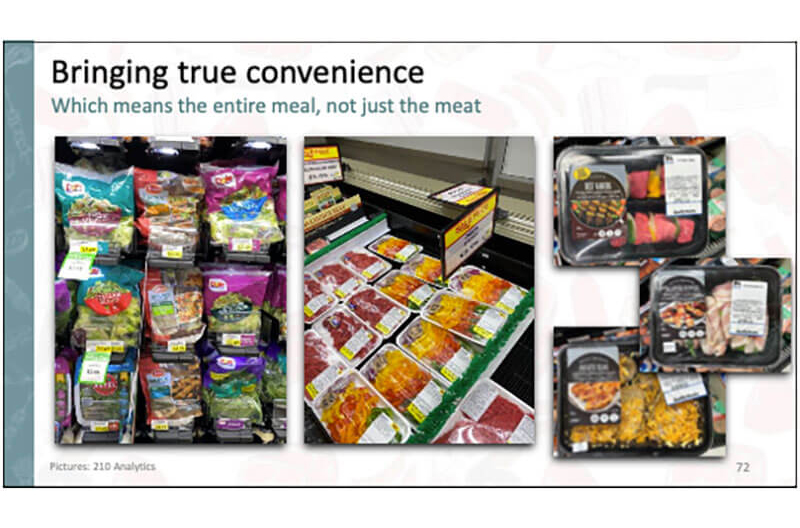(Editor’s note: This is the third in a three-part series covering the release of the annual Power of Meat report. For part 1, click here. For part 2, click here.)
Consumers like convenience and meat shoppers are no different. Anything grocers can do to help their shoppers with planning, shopping, preparation and cleanup will pay off, according to Anne-Marie Roerink, principal of 210 Analytics and presenter of the 17th annual Power of Meat report. This is what she believes is “going to be one of the biggest pockets of growth for 2022.”
FMI and the North American Meat Institute hosted an online presentation of the report March 8.
Value-added sales – such as pre-cut, marinated, seasoned, burgers, kebabs or similar items – will be important, Roerink said. Over the last eight years, there has been a large increase in the percent of people buying value-added sale items or buying them frequently. Also, the number of shoppers who never buy them continues to decline.
“So both more people are buying them, and they’re buying them more frequently. And that’s why I believe we’re going to see continued growth here,” she said.
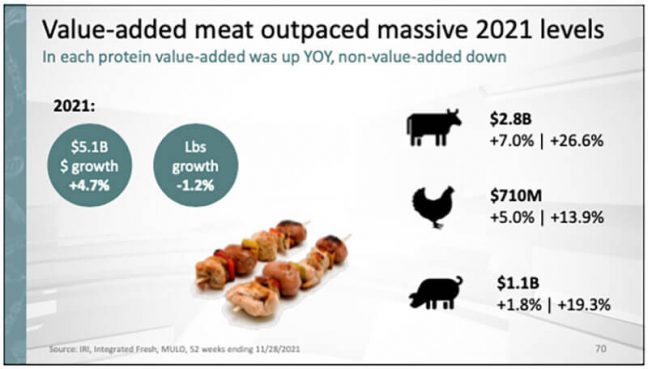
And while saving time is the No. 1 reason shoppers are buying value-added items, at 28 percent, it is not the only one. Other reasons include:
- “We think the meat department or whoever did this creates a better taste and flavor than if I would do it,” 22 percent.
- “It’s something different,” 20 percent.
- “I don’t have to buy all those different ingredients,” 13 percent.
- “All equally,” 11 percent.
“Think about that in your marketing and merchandising. It is not just about saving time, but also about the flavor and the ‘light on effort’ like it says on this package right here,” Roerink said. “But absolutely, value added has outpaced the massive 2021 levels overall – the highest growth of 4.7 percent versus a year ago, pounds almost even and just down 1 percent. And we saw some really good performances by beef, chicken and pork, where the numbers of value added are still sitting far, far ahead of the 2019 levels.”
And it wasn’t just the meat, but also prepared side dishes and entrees, processed chicken and meal kits.
Roerink gave an example of Food Lion’s heat-and-eat solutions packaged together rather than making shoppers run to the deli and to the produce department.
“Really think about the entire meal, not just the meat,” she added.
Inspiration for meals also comes through recipes. Having those online where all the ingredients can be added to the shopper’s basket in one click is becoming very popular, according to the report. The idea of narrowing the step between inspiration and purchase is something a lot of retailers are pursuing, Roerink said.
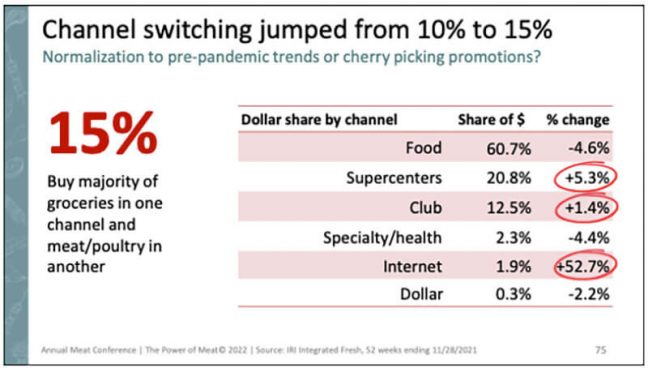
Meat channel choices
There has been a bit of an increase in people switching between where they buy groceries and meat. That number was low in 2020, as people combined all of their needs into one trip, Roerink said. Now, there is a little more of that, with channels such as supercenters, clubs and the internet doing well.
While the internet share of dollars is less than 2 percent, she said there will continue to be “aggressive growth numbers there.”
Nearly 80 percent of younger shoppers, Gen Z, say what they buy in store they also buy online. That number drops to 38 percent for Baby Boomers. When looking at what is not bought online, steak is the biggest item, along with roast beef, pork and chicken. Roerink described these as higher margin, higher ring items.
“If those are items that are not bought online, what do people do instead? Nearly half either say, ‘Well, I buy something that I am comfortable buying online,’ which tends to be your grinds, your bacons, your sausages, etc. ‘I buy the frozen counterpart’ or ‘I just forego the purchase altogether,’” she said.
“In those cases, did we substitute a nice high ring, high margin item because people don’t have the confidence? This is really something important to keep in mind.”
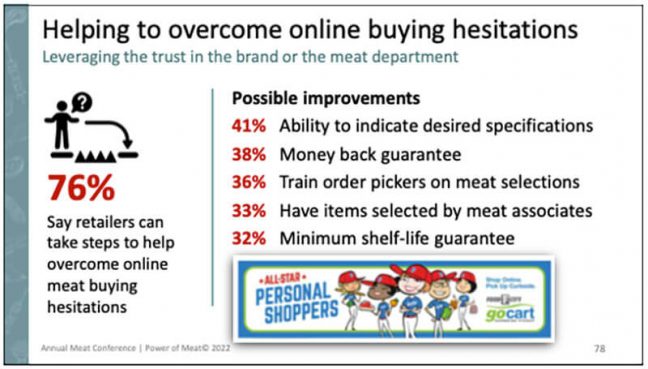
Finding a way to make people comfortable buying fresh meat online is important. Roerink cited an example of Food City’s promise of a personal shopper “who will get to know your preferences over time.”
“But it’s really about the ability to indicate specifications, training people, having items selected by associates,” she said. “So there’s many things that we can do to leverage that trust that people have in the meat department, and also transfer that to an online order.”
Making sure the description on the meat packages is informative is also important for online sales. One example was a package of a ribeye beef steak from Hy-Vee.
“Look at this description. It doesn’t just say steak, it talks about the highest standards of tenderness, quality, talks about the vitamin Bs, the proteins and a nutrition label as well,” Roerink said. “[It’s] a great example of how we can leverage the added real estate that we have online.”
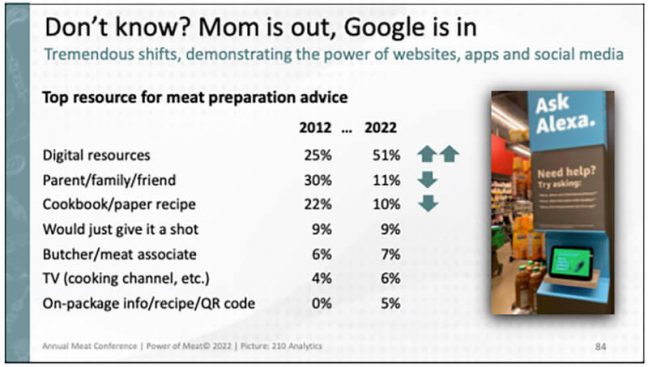
Meat preparation
People continue to look for inspiration and advice on preparing meat. Ten years ago, 30 percent were finding that inspiration from mom, family and friends, followed by digital and then by cookbooks. In 2022, it’s all about digital resources, at 51 percent, according to Roerink.
“Mom is hanging in there in second at 11 percent and cookbooks 10 percent. But as you can see, what has not really changed is the butcher or meat associate at 6 to 7 percent. So for us as the meat industry to have the biggest impact on meat preparation advice, it really sits in those digital resources,” she said.
These include recipe websites, social media and store websites. While younger generations are moving more toward social media, the Boomer population is driving the recipe and store websites, Roerink said.
“Really, inspiration is everywhere. And that’s an opportunity for us by having very beautiful recipes on the back of a package,” she said. “If you have a big roast, show what it looks like with some cooked imagery there as well.”
She said QR codes are another way to link the in-store displays to online content.
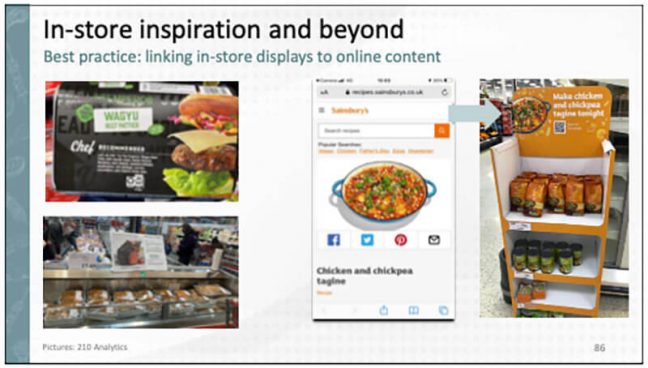
It is important for retailers to continue to encourage their shoppers to try new things, Roerink added. In store, be aware of the fajita mix that is ready to cook or bring in the chef from the deli or the butcher from the meat department.
“These are great ways to have variety continue to be our superpower,” she said.
Where do online shoppers go for inspiration? Google is No. 1, along with YouTube, Pinterest, Tik Tok and other sites.
“All of those are very, very visual. You can see that the power of video is very important these days,” Roerink said. “And you can also see how much those online shoppers are focused on these digital and social media resources. So again, narrowing that step between inspiration and purchase is a big opportunity for us today.”
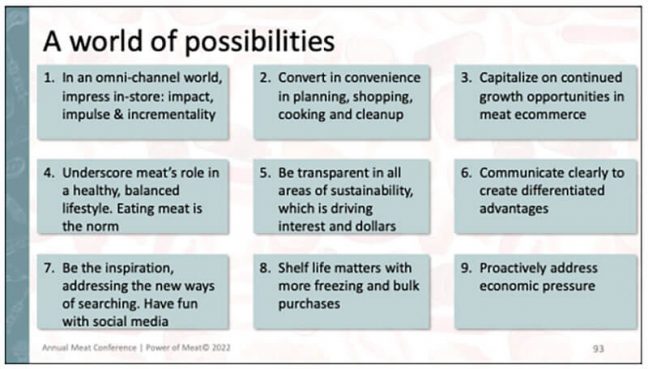
Key takeaways
Grocers will have a “very difficult time” going up against the numbers from 2020 and 2021, the two biggest years of grocery retailing and meat retailing. But Roerink still thinks there are pockets of growth.
In an omnichannel world, it’s all about impressing in store – impact, impulse, incrementally – the three “I’s” of merchandising, she noted.
“At the same time, though, we have an opportunity to convert that idea of convenience – planning, shopping, cooking, cleanup, not just preparation,” she said. “And while we have to impress in store, there’s continued growth in e-commerce. I’m absolutely convinced of that.”
According to Roerink, it is clear that a lot of shoppers are looking for the “better for you” area. They may not always make that purchase, especially when inflation is very high. “But that desire is there,” she said. “And that means that we’re working with a willing shopper, and eating meat remains the norm. It is just for us to figure out how can we make that as easy as possible.”
Transparency also is very important. While consumers make a lot of assumptions about meat, it is up to retailers to make sure those assumptions are correct and to understand what the claims mean on claims-based products.
“Let’s make sure people understand what our lingo actually means,” Roerink said.
She added that her biggest message from the Power of Meat report was to “be the inspiration.”
“Have fun with social media and make sure that that step between inspiration and purchase is as short as it can be.”
To Roerink, shelf life matters. A lot of people go to different ways in which they can buy more – when it’s on sale, buy bulk packages, freeze and use over time.
“Last but not least, that economic pressure is real,” she said. “Virtually all consumers are aware and are adjusting.”
The Power of Meat study was conducted by 210 Analytics on behalf of FMI – The Food Industry Association and the Meat Institute’s Foundation for Meat and Poultry Research and Education.
For more information on the report, click here.

